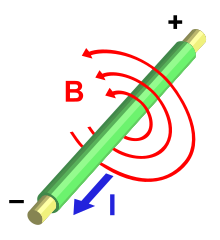Elektromagnet


En elektromagnet består normalt af en elektrisk spole, der genererer et magnetfelt når der sendes jævnstrøm gennem spolen.
Spolen kan evt. indeholde en kerne af et ferromagnetisk materiale som f.eks. jern, hvilket under normale betingelser (dvs. hvis den magnetiske feltstyrke ikke er stor nok til at få kernen til at gå i mætning) forstærker magnetfeltet.
Superledende elektromagneter benyttes uden kerne, da der kan opnås et langt større magnetfelt uden.
Elektromagnetisme blev opdaget i 1820 af den danske fysiker H. C. Ørsted.
Man skal vide 2 ting for at finde en kerneløs elektromagnets styrke:
- antal vindinger på spolen
- strømmens størrelse i gennem spolen.
Den totale strøm = spolens vindingstal * strømmens størrelse
| Spire Denne naturvidenskabsartikel er en spire som bør udbygges. Du er velkommen til at hjælpe Wikipedia ved at udvide den. |
Medier brugt på denne side
Forfatter/Opretter:
- Urutseg: Blank_template.svg
- AllyUnion, Stannered: Science-symbol-2.svg
- Ain92: combination
Science stub icon.
A simple electromagnet, consisting of an insulated wire wound around an iron core. When an electric current is passed through the wire, the iron core becomes a magnet, with a north pole at one end and a south pole at the other.
Forfatter/Opretter: User:Stannered, Licens: CC BY-SA 3.0
Illustration of a magnetic field around a wire conductor through which electric current is flowing. I is the direction of current flow. B is the magnetic field. The direction of the magnetic field obeys the right hand rule; if the wire is grasped by the right hand with the thumb in the direction of current flow, the fingers will point in the direction of the magnetic field lines. Traced by User:Stannered using en:OpenOffice.org Draw 2.0, from an original render by Wapcaplet


